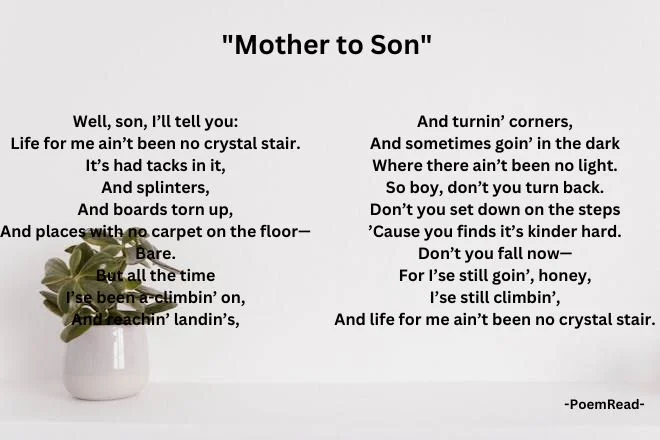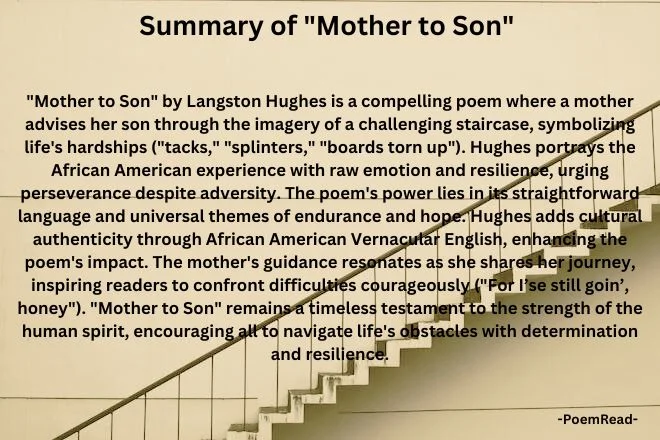“Mother to Son” by Langston Hughes: An Analysis
July 11, 2024 | by poemread.com

“Mother to Son” by Langston Hughes is a moving and powerful poem that deeply connects with readers. Through the voice of a mother advising her son, Hughes effectively captures the struggles and resilience inherent in the African American experience. The poem is celebrated for its simplicity, emotional depth, and lasting message of perseverance. Let’s explore its different aspects to fully grasp its impact.
"Mother to Son"
Well, son, I’ll tell you:
Life for me ain’t been no crystal stair.
It’s had tacks in it,
And splinters,
And boards torn up,
And places with no carpet on the floor—
Bare.
But all the time
I’se been a-climbin’ on,
And reachin’ landin’s,
And turnin’ corners,
And sometimes goin’ in the dark
Where there ain’t been no light.
So boy, don’t you turn back.
Don’t you set down on the steps
’Cause you finds it’s kinder hard.
Don’t you fall now—
For I’se still goin’, honey,
I’se still climbin’,
And life for me ain’t been no crystal stair.
Content
- About the Author: Langston Hughes
- Subject of "Mother to Son"
- Context of "Mother to Son"
- Theme and Tone of "Mother to Son"
- Persona, Setting, and Narrative in "Mother to Son"
- Form and Structure of "Mother to Son"
- Line-by-Line Analysis of "Mother to Son"
- Poetic and Literary Devices used in "Mother to Son"
- Implications and Meanings of "Mother to Son"
- Interactive Summary
About the Author: Langston Hughes
Langston Hughes, born on February 1, 1902, was a leading figure in the Harlem Renaissance, a cultural movement that celebrated African American art, literature, and music in the 1920s. Hughes’s work is known for its insightful portrayals of black life in America from the twenties through the sixties.
His poetry, novels, plays, and essays often address themes of identity, struggle, and social justice. Hughes had a unique ability to capture the everyday experiences of African Americans, and his work remains influential in American literature.
Subject of “Mother to Son”
The subject of “Mother to Son” centers on a mother’s advice to her son about life’s hardships. She uses the metaphor of a staircase to describe her journey, highlighting the challenges and obstacles she has faced. Specifically, the mother speaks candidly about her experiences, mentioning tacks, splinters, and torn-up boards. These elements symbolize the pain and difficulties she’s encountered.
Despite these hardships, she emphasizes her perseverance, continually climbing and moving forward. Therefore, she encourages her son to do the same, advising him not to turn back or give up, no matter how tough things get. Ultimately, the poem is a powerful testament to the human spirit’s resilience and the importance of perseverance. It conveys a universal message about facing and overcoming adversity.
Context of “Mother to Son”
“Mother to Son” was published in 1922, a time when African Americans faced significant social and economic challenges. This period followed the Great Migration, where many African Americans moved from the rural South to urban areas in the North. They sought better opportunities but often encountered new forms of hardship. Consequently, the poem reflects these struggles, capturing the resilience needed to navigate a life filled with obstacles.
Langston Hughes, a prominent figure in the Harlem Renaissance, wrote this poem to highlight the strength and endurance of the black community. Additionally, his use of African American Vernacular English (AAVE) gives the poem authenticity and depth, making it relatable to readers from all backgrounds. Overall, the context highlights the fight for equality and the enduring hope that fuels it.
Theme and Tone of “Mother to Son”

Theme
The primary theme of “Mother to Son” is perseverance in the face of adversity. The poem conveys a powerful message about enduring life’s hardships and continuing to strive forward, no matter how difficult the journey. The mother’s metaphor of a rough staircase illustrates the challenges she has faced. Despite these obstacles, she continues to climb, demonstrating her resilience and determination.
This theme of perseverance is universal and timeless, connecting with anyone who has faced struggles. Additionally, the poem touches on themes of parental love and guidance, as the mother imparts wisdom and encouragement to her son. She wants him to understand that life will not be easy, but he must persist and keep moving forward.
Tone
The tone of “Mother to Son” is both earnest and encouraging. The mother speaks with heartfelt sincerity, sharing her personal struggles in a straightforward manner. Her tone is serious as she describes the hardships she has faced, using vivid imagery to convey the difficulties of her journey.
Despite the serious subject matter, the tone also carries a sense of hope and determination. The mother’s words are meant to inspire her son to persevere, and her encouraging tone reflects her unwavering belief in his ability to overcome obstacles. Overall, the tone combines elements of realism and optimism, creating a powerful and motivating message for readers.
Persona, Setting, and Narrative in “Mother to Son”
Persona
The persona in “Mother to Son” is a resilient African American mother who addresses her son with candid advice about life’s challenges. Her voice is authoritative, wise, and nurturing, reflecting her own experiences of hardship and perseverance. Through her persona, Hughes portrays strength and determination, emphasizing the importance of resilience in overcoming adversity.
Setting
The setting of the poem is metaphorical rather than literal. It revolves around the imagery of a staircase, which symbolizes the journey of life with its ups and downs, obstacles, and difficulties. The setting is not confined to a specific physical location but rather encompasses the universal experience of facing challenges and striving for progress despite setbacks.
Narrative
The narrative unfolds through the mother’s monologue to her son, recounting her struggles and imparting valuable life lessons. It is a personal narrative steeped in cultural authenticity, conveyed through African American Vernacular English. The narrative style is direct and emotive, drawing readers into the intimate conversation between mother and son. Hughes uses the narrative to explore themes of generational wisdom, resilience, and hope, resonating with readers through its universal truths and heartfelt delivery.
Form and Structure of “Mother to Son”
“Mother to Son” is a free verse poem, which means it does not follow a specific rhyme scheme or meter. This lack of formal structure allows Langston Hughes to create a more natural, conversational tone, as if the mother is speaking directly to her son. The poem consists of a single stanza with 20 lines, which helps to maintain the flow and intensity of the mother’s message without interruption.
The irregular line lengths and the use of enjambment, where a sentence or phrase runs over into the next line without a pause, contribute to the poem’s conversational rhythm. Hughes uses these techniques to mimic the natural patterns of speech, making the mother’s voice more authentic and relatable. Additionally, the varied line lengths and breaks in the poem highlight key phrases and words, emphasizing the struggles and determination described by the mother.
Hughes also uses minimal punctuation, which adds to the fluidity of the poem. The pauses and breaks in the lines often come naturally, guiding the reader through the mother’s narrative without disrupting the flow. This approach allows the emotional weight of her words to come through more powerfully.
Line-by-Line Analysis of “Mother to Son”

“Well, son, I’ll tell you:”
The poem opens with a conversational tone, establishing an intimate dialogue between the mother and her son. The word “Well” suggests a casual beginning, but the forthcoming message is serious. The mother is preparing her son for important life advice, indicating that what she’s about to share is significant and heartfelt.
“Life for me ain’t been no crystal stair.”
Here, the mother uses a powerful metaphor to describe her life. A “crystal stair” symbolizes a life of ease and elegance, something clear and unblemished. By stating that her life has not been a crystal stair, she immediately sets the stage for the contrast: her life has been difficult and far from easy. This metaphor underscores the theme of struggle and resilience.
“It’s had tacks in it,”
The “tacks” symbolize small but painful obstacles she has encountered. Tacks are sharp and cause discomfort, reflecting the numerous minor yet hurtful challenges in her life. This imagery helps the reader visualize the specific difficulties the mother has faced.
“And splinters,”
Continuing the metaphor, “splinters” suggest further pain and discomfort. Splinters are small fragments of wood that cause irritation and pain, indicating that her journey has been marked by continuous, nagging problems. This line builds on the previous one, reinforcing the idea of persistent hardship.
“And boards torn up,”
“Torn up boards” indicate larger, more significant obstacles. This imagery suggests instability and danger, as walking on torn-up boards is precarious. It signifies that parts of her life have been broken and difficult to navigate, highlighting the severity of the challenges she has faced.
“And places with no carpet on the floor—”
This line adds another layer to the metaphor, describing the bare, uncomfortable conditions she has experienced. Carpets are associated with comfort and warmth, so their absence suggests a lack of comfort and ease in her life. This imagery continues to paint a picture of a life filled with hardship.
“Bare.”
The single word “Bare” stands alone, emphasizing the starkness of her experience. It underscores the absence of luxury and comfort, reinforcing the raw and unembellished nature of her life’s journey. This word’s isolation gives it more impact, driving home the point of her struggles.
“But all the time”
This phrase marks a shift in the poem. Despite the hardships described, the mother indicates that she has never stopped moving forward. The word “But” signals a contrast to the preceding lines, preparing the reader for a message of perseverance.
“I’se been a-climbin’ on,”
Using dialect, the mother expresses her continuous effort to keep going. “I’se been a-climbin’ on” emphasizes her persistence. The use of “a-climbin’” instead of “climbing” adds authenticity to her voice, making her struggle feel more personal and real.
“And reachin’ landin’s,”
“Landin’s” or landings symbolize moments of rest or achievement along her journey. These are the brief periods where she could pause and regain strength before continuing. This imagery suggests that despite the constant struggle, there have been small victories and moments of respite.
“And turnin’ corners,”
Turning corners implies changes in direction or new phases in life. It indicates that her journey has not been linear but has involved navigating different paths and overcoming new challenges. This line suggests adaptability and the ability to find new ways forward.
“And sometimes goin’ in the dark”
“Goin’ in the dark” symbolizes facing the unknown and experiencing fear and uncertainty. The darkness represents times when she couldn’t see the way forward or didn’t know what to expect, highlighting the courage it took to continue.
“Where there ain’t been no light.”
This line continues the previous thought, emphasizing the absence of guidance or clarity. The lack of light signifies moments of hopelessness or confusion. It underscores the depth of the mother’s struggles, showing that she has persevered even without clear direction.
“So boy, don’t you turn back.”
The mother shifts from recounting her own experiences to directly advising her son. She urges him not to turn back, emphasizing the importance of perseverance. Her tone is firm and commanding, reflecting the seriousness of her advice.
“Don’t you set down on the steps”
She continues her advice, warning her son against giving up or becoming complacent. Sitting down on the steps symbolizes taking a break or quitting. The mother’s message is clear: he must keep moving forward, no matter how difficult the journey.
“’Cause you finds it’s kinder hard.”
This line acknowledges that life will indeed be hard. The use of “kinder” adds a colloquial touch, making the advice more personal and relatable. The mother is preparing her son for the inevitable difficulties he will face.
“Don’t you fall now—”
Her warning becomes more urgent here. Falling symbolizes failure or giving up entirely. The dash creates a pause, adding emphasis to her plea and giving her words a sense of immediacy.
“For I’se still goin’, honey,”
She reassures her son by sharing her own ongoing struggle. Despite all the hardships, she continues to move forward. The term “honey” adds a touch of affection, reminding her son of her love and support.
“I’se still climbin’,”
Repetition of “I’se still” emphasizes her continued effort and determination. She hasn’t stopped climbing, reinforcing the message that perseverance is key. This line also serves as a motivational example for her son.
“And life for me ain’t been no crystal stair.”
The poem concludes with a repetition of the earlier metaphor, bringing the message full circle. By reiterating that her life hasn’t been easy, the mother reinforces the central theme of enduring and overcoming adversity. This repetition solidifies the impact of her advice, leaving a lasting impression on her son and the reader.
Poetic and Literary Devices used in “Mother to Son”
Metaphor
The central metaphor of the poem is the staircase, which represents the mother’s life journey. Hughes uses this metaphor to illustrate the challenges and obstacles she has faced. Examples include:
- “Life for me ain’t been no crystal stair.”
- This line sets up the metaphor, comparing life to a staircase. A “crystal stair” would be smooth and easy, symbolizing an ideal, trouble-free life. By stating that her life has not been a crystal stair, the mother indicates that her life has been difficult.
- “It’s had tacks in it,”
- The “tacks” represent small, sharp obstacles that cause pain and discomfort. These are the minor but painful challenges she has faced.
- “And splinters,”
- “Splinters” also symbolize small, irritating problems. Like tacks, splinters are painful and hard to ignore, representing persistent issues in her life.
- “And boards torn up,”
- “Boards torn up” signify major disruptions and obstacles. These larger challenges create instability and danger in her path.
- “And places with no carpet on the floor—Bare.”
- The lack of carpet symbolizes the absence of comfort and ease. “Bare” implies that she has faced times without any cushioning or support, making her journey even harder.
Dialect
Hughes uses African American Vernacular English (AAVE) to give authenticity to the mother’s voice. This choice grounds the poem in a specific cultural context and adds emotional depth. Examples include:
- “I’se been a-climbin’ on,”
- The use of “I’se” and “a-climbin’” reflects the mother’s natural speech, making her voice more personal and real. It indicates her continuous effort to keep moving forward despite difficulties.
- “Don’t you set down on the steps”
- This line, in dialect, advises the son not to give up or become complacent. “Set down” means to sit down, implying stopping or quitting.
- “For I’se still goin’, honey,”
- The mother reassures her son by using affectionate language (“honey”) and reinforcing that she continues to move forward despite hardships.
- “I’se still climbin’,”
- Repetition in dialect emphasizes her ongoing struggle and determination. She has not stopped climbing, serving as a role model for her son.
Imagery
The poem is rich with vivid imagery, which helps to bring the mother’s experiences to life. These descriptive elements create a clear picture of her struggles. Examples include:
- “It’s had tacks in it,”
- Imagery of “tacks” helps the reader visualize sharp, painful obstacles on the staircase, representing minor yet significant difficulties.
- “And splinters,”
- “Splinters” create an image of small, persistent problems that cause pain, adding to the overall depiction of a challenging life.
- “And boards torn up,”
- “Boards torn up” evoke a sense of danger and instability, making the reader imagine walking on a hazardous, broken staircase.
- “And places with no carpet on the floor—Bare.”
- This line creates a stark image of discomfort and lack of support, emphasizing the roughness of her journey.
- “And sometimes goin’ in the dark / Where there ain’t been no light.”
- The imagery of darkness and the absence of light represents times of fear, uncertainty, and lack of guidance.

Repetition
Repetition emphasizes the mother’s persistence and the ongoing nature of her struggle. Hughes uses this device to reinforce the poem’s theme of perseverance. Examples include:
- “I’se been a-climbin’ on,”
- Repetition of “climbin’” underscores her continuous effort and determination to keep moving forward.
- “I’se still climbin’,”
- Repeating the idea of climbing highlights her ongoing struggle and reinforces her message of perseverance.
- “Life for me ain’t been no crystal stair.”
- Repetition of this line at the beginning and end of the poem reinforces the central metaphor and theme, making the mother’s message more impactful.
Symbolism
Various elements in the poem serve as symbols, adding deeper meaning to the text. These symbols help connect the mother’s personal experiences to universal themes. Examples include:
- The staircase
- The staircase symbolizes the journey of life, with its ups and downs representing the trials and tribulations faced along the way.
- “Tacks,” “splinters,” and “boards torn up”
- These elements symbolize the specific hardships and obstacles she has faced, each adding to the metaphor of a challenging life path.
- “Dark” and “light”
- Darkness symbolizes moments of fear and uncertainty, while light represents hope and clarity. These contrasts highlight the emotional highs and lows of her journey.
Alliteration
Hughes uses alliteration to create a musical quality in the poem. This technique enhances the reading experience by adding rhythm and flow. Examples include:
- “Don’t you set down on the steps,”
- The repetition of the ‘s’ sound creates a subtle musicality, adding to the poem’s rhythm.
- “Life for me ain’t been no crystal stair.”
- The repetition of the ‘s’ sound in “crystal stair” adds a smooth, flowing quality to the line.
Enjambment
The use of enjambment, where lines run into each other without punctuation, creates a flowing, conversational rhythm. This technique mirrors the natural speech patterns of the mother, making her words feel more spontaneous and heartfelt. Examples include:
- “And sometimes goin’ in the dark / Where there ain’t been no light.”
- The lack of punctuation between these lines creates a seamless flow, reflecting the continuous nature of her journey through dark times.
- “Don’t you set down on the steps / ’Cause you finds it’s kinder hard.”
- Enjambment here mimics natural speech, making the mother’s advice feel more immediate and direct.
Personification
Hughes uses personification to give human qualities to non-human objects or concepts, adding depth to the poem:
- “Life for me ain’t been no crystal stair.”
- Here, life is personified as if it can present challenges and obstacles, making it more relatable and vivid.
Oxymoron
An oxymoron is a figure of speech that combines contradictory terms for emphasis or dramatic effect:
- “Life for me ain’t been no crystal stair.”
- The juxtaposition of “crystal” (which implies clarity and smoothness) with “stair” (which implies roughness and obstacles) creates an oxymoron that highlights the stark contrast between idealized life and the harsh reality.
Anaphora
Anaphora involves the repetition of a word or phrase at the beginning of successive clauses or lines, creating a rhythmic effect:
- “And,” used at the beginning of several lines, such as “And sometimes goin’ in the dark / Where there ain’t been no light.” This repetition emphasizes the continuation of challenges and adds to the poem’s rhythm and flow.
Hyperbole
Hyperbole is an exaggeration used for emphasis or effect:
- “Life for me ain’t been no crystal stair.”
- While not an extreme exaggeration, the use of “ain’t been no crystal stair” exaggerates the difficulty of the mother’s life, emphasizing the severity of her struggles.
Irony
Irony involves using language that conveys the opposite of what is expected or intended, often for humorous or emphatic effect:
- “Life for me ain’t been no crystal stair.”
- The irony here lies in the juxtaposition of the idealized “crystal stair” with the reality of the mother’s difficult life. It shows the disparity between expectation and reality.
Implications and Meanings of “Mother to Son”
“Mother to Son” by Langston Hughes carries deep implications and layers of meaning, resonating with readers on personal and universal levels. Here’s a detailed exploration of its key implications and meanings:
Resilience and Perseverance
The poem centers on resilience in adversity. Hughes uses the metaphor of a staircase to depict life’s challenges (“tacks,” “splinters,” “boards torn up”). Despite these hardships, the mother emphasizes her determination to keep moving forward (“I’se been a-climbin’ on,” “I’se still climbin’”). This resilience teaches her son—and the reader—the importance of perseverance in overcoming difficulties.
Generational Wisdom and Guidance
“Mother to Son” explores the wisdom passed from one generation to the next. The mother’s advice isn’t just about surviving hardships but also about imparting life lessons (“So boy, don’t you turn back,” “Don’t you set down on the steps”). Her words reflect wisdom gained from experience, guiding her son through life’s challenges and highlighting the enduring bond between parent and child.
The Reality of Struggle vs. Idealized Expectations
Hughes contrasts the idealized “crystal stair” with the harsh reality of life (“Life for me ain’t been no crystal stair”). This critique challenges romanticized views of success, advocating for a realistic understanding of resilience and achievement amid adversity.
Hope and Endurance
Despite hardships, the poem conveys hope and endurance. The mother’s determination (“For I’se still goin’, honey,” “I’se still climbin’”) embodies resilience in the face of darkness (“sometimes goin’ in the dark / Where there ain’t been no light”), inspiring hope and strength.
Cultural Identity and Authenticity
Through dialect and cultural references, Hughes captures the authenticity of African American experience. The mother’s use of African American Vernacular English (“I’se been a-climbin’ on,” “Don’t you fall now—”) grounds the poem, reflecting African American realities and resilience.
Universal Themes of Human Experience
While rooted in African American culture, “Mother to Son” addresses universal themes of struggle, perseverance, and wisdom across generations. Its emotional resonance transcends cultural boundaries, making it meaningful to diverse readers.
Interactive Summary

“Mother to Son” by Langston Hughes is a powerful poem that uses the metaphor of a staircase to illustrate life’s challenges and the resilience needed to overcome them. The mother’s guidance to her son reflects wisdom derived from her own difficult experiences, emphasizing the importance of perseverance and determination in adversity.
Through vibrant imagery—like “tacks,” “splinters,” and “boards torn up”—Hughes portrays a tough journey marked by hardships and obstacles. The poem’s use of African American Vernacular English adds authenticity and cultural depth, grounding the narrative while addressing universal themes of hope, endurance, and the passage of wisdom between generations. “Mother to Son” inspires readers to reflect on their own struggles and find strength in facing life’s challenges with resilience and determination.
If you enjoyed our analysis of “Mother to Son” by Langston Hughes, you might find our exploration of “As I Grew Older” by the same author equally compelling. It explores themes of personal struggle, resilience, and the significant influence of the African American cultural experience.
RELATED POSTS
View all



